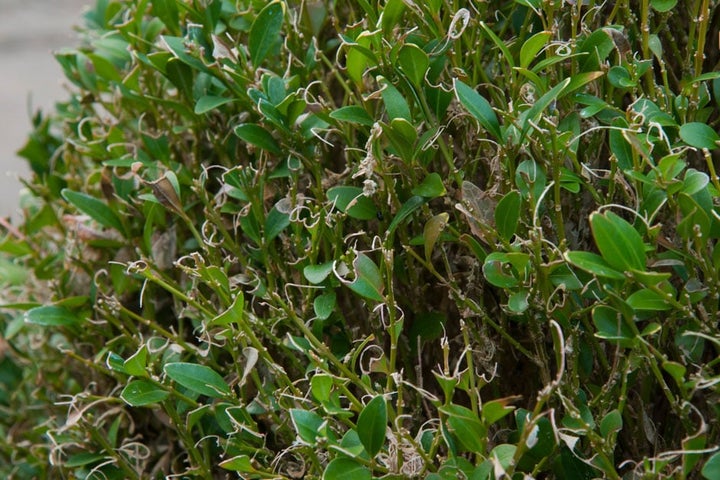
Quick facts
Common name - Box tree caterpillar
Scientific name - Cydalima perspectalis
Plants affected - Box (Buxus)
Main symptoms - Foliage is eaten and leaves webbed together
Most active - April-October
What is box tree caterpillar?
Box tree caterpillars are the larvae of a moth that feeds on box (Buxus) plants. It is to East Asia and became established in Europe in 2007. Although the first adult moth arrived in Britain in 2007, followed by several moths to light traps in 2008, caterpillars were not found in private gardens until 2011 in the home counties. By the end of 2014 the moth had become established in parts of London and surrounding areas. For growers in the south-east of England, it is now a problem that is likely to reoccur repeatedly throughout the and in successive years.

Symptoms
Gardeners are likely to become aware of box tree caterpillar when they notice defoliation or find webbing and caterpillars on box plants.
- The caterpillars eat box leaves and produce webbing over their feeding area. Plants may also show patches of dieback, which can be especially apparent on trimmed plants. This is not to be confused with the dieback caused by the disease known as box blight
- Newly hatched caterpillars are greenish-yellow, with black heads. Older caterpillars reach up to 4 cm (1¼ in) in length and have a greenish/yellow body with thick black and thin white stripes along the length of the body
- Caterpillars are also capable of stripping , which can result in girdling of affected sections
- The pupae are concealed in a cocoon of white webbing spun among leaves and twigs
- The adult moth usually has white wings with a faintly iridescent brown border, although the wings can be completely brown or clear. The moth has a wingspan of around 4 cm (1¼ in)
- The pale yellow, flattish eggs are laid sheet-like, overlapping each other, on box leaves. These are very difficult to find

Management
- The caterpillars have a range of natural enemies, including parasitoid flies, parasitoid wasps, social wasps, spiders and ants
- There have been reports of garden birds including blackbirds, starlings, magpies and tits feeding on the caterpillars in some locations. It is not yet clear if this predation will result in a reduction of box tree moth numbers
- Pheromone traps, can indicate whether there are moths in the area and their level of activity. These are available from several suppliers including Agralan, Dragonfli and Solabiol
- Check box plants frequently from early spring onwards before any overwintering caterpillars become large enough to cause noticeable damage
- Monitor plants from May onwards so that action can be taken to prevent a damaging population developing: eggs may be laid by incoming females even if your plant was not affected in early spring by the overwintering generation
- Where practical, caterpillars should be removed by hand
- The mixed nematode biological control sold as Fruit and Vegetable Protection has some effect on the caterpillars, though nematodes have the potential to infect non-target animals so should therefore be used with care
- Consider choosing alternatives to box plants (see below)
- Biological control suppliers (Adobe Acrobat pdf document)
Survey
Have you seen box tree moth? We would like to know.
As part of our research, the RHS would like to know where box tree moth has been seen. Please submit your records via our box tree moth survey (expected time to complete survey = two minutes).
Between 2015 and 2016, over 800 records of the moth were received. This jumped to over 3000 in 2017 and since 2018 have remained at more than 5 000 a year. The box tree moth is now considered to be a “common resident”, being widely distributed across England, particularly the south-east. It is also present in Wales, Scotland, Ireland and Northern Ireland.
Thank you to everyone who has submitted records so far.
- Watch an animated map of the results from the box tree caterpillar survey (links to YouTube)
- See all sightings you can submit to help our research
Choose alternatives to box
If you are looking for an alternative to box then there are plenty of shrubs that lend themselves similarly well to clipping.
Where it has become impractical to control box tree caterpillar, consider using a different hedge or topiary plant. Read our guide to choosing box alternatives, and then browse our box alternatives selection page to find a plant that works for you.
Read more about our ongoing Box alternatives trial where a range of compact evergreen shrubs are being grown at RHS Garden Wisley. The trial is situated in the Walled Garden at the end of the Jellicoe Canal in front of The Old Laboratory building. No box alternative has all the attributes of box, however, several of the shrubs are promising options; there are alternatives with small leaves that can be clipped into formal hedging styles.
Biology
There are at least two generations of the box tree moth a year, with the majority of feeding damage caused between March and October.
Box tree moth overwinters as small caterpillars, hidden between box leaves that have been webbed together in late autumn. These caterpillars begin to become active as the weather warms in the spring – they have been observed feeding as early as February on particularly warm days. By June, caterpillars will have finished feeding, pupated and emerged as adult moths.
There is then a second emergence of adults in late July/early August as the next generation of box tree moths emerge, looking for mates. During summer overlapping of generations has been observed, with multiple life stages of the moth present at the same time. However, by late September/October the majority of the population are early instar caterpillars.
The adult moths are good flyers and are attracted to light.


























